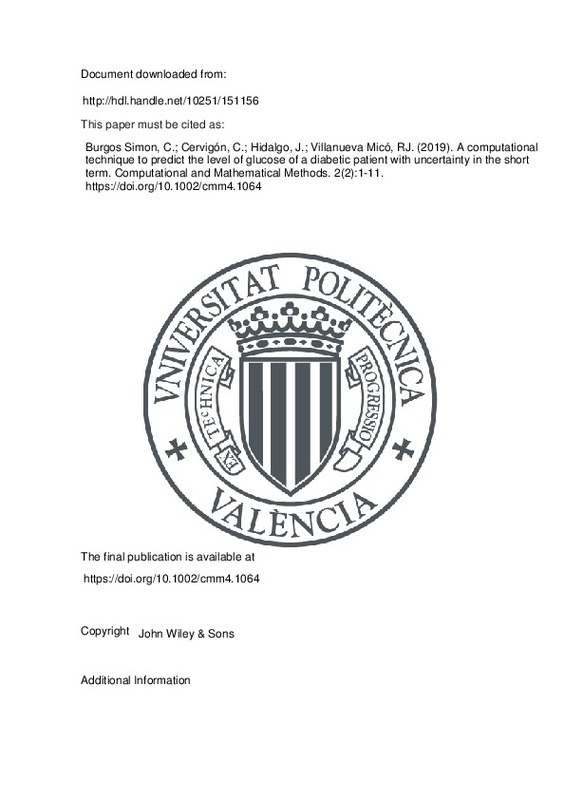JavaScript is disabled for your browser. Some features of this site may not work without it.
Buscar en RiuNet
Listar
Mi cuenta
Estadísticas
Ayuda RiuNet
Admin. UPV
A computational technique to predict the level of glucose of a diabetic patient with uncertainty in the short term
Mostrar el registro sencillo del ítem
Ficheros en el ítem
| dc.contributor.author | Burgos Simon, Clara
|
es_ES |
| dc.contributor.author | Cervigón, Carlos
|
es_ES |
| dc.contributor.author | Hidalgo, José-Ignacio
|
es_ES |
| dc.contributor.author | Villanueva Micó, Rafael Jacinto
|
es_ES |
| dc.date.accessioned | 2020-10-06T03:31:35Z | |
| dc.date.available | 2020-10-06T03:31:35Z | |
| dc.date.issued | 2019 | es_ES |
| dc.identifier.uri | http://hdl.handle.net/10251/151156 | |
| dc.description.abstract | [EN] On advanced stages of the disease, diabetic patients have to inject insulin doses to maintain blood glucose levels inside of a healthy range. The decision of how much insulin is injected implies somehow to predict the level of glucose they will have after a certain time. Due to the sudden changes in the glucose levels, their estimation is a very difficult task. If we were able to give reliable estimations in advance, it would facilitate the process of taking therapeutic decisions to control the disease and improve the health of the patient. In this work, we present a technique to estimate the glucose level of a diabetic patient, capturing the measurement errors produced by continuous glucose monitoring systems (CGMSs), smart devices that measure glucose levels. To do that, we will use a model of glucose dynamics and we calibrate it with the aim to capture the glucose level data of the patient in a time interval of 30 minutes and the uncertainty given by the glucose measurement. Then, we use the calibrated parameters to predict the levels of glucose over the next 15 minutes. Repeating this procedure every 15 minutes, we are able to give short¿term accurate predictions. | es_ES |
| dc.description.sponsorship | This work has been partially supported by the Spanish Ministerio de Economía y Competitividad under grant MTM2017-89664-P and RTI2018-095180-B-I00 and by Fundación Eugenio Rodriguez Pascual 2019 -GLENO Project | es_ES |
| dc.language | Inglés | es_ES |
| dc.publisher | John Wiley & Sons | es_ES |
| dc.relation.ispartof | Computational and Mathematical Methods | es_ES |
| dc.rights | Reserva de todos los derechos | es_ES |
| dc.subject.classification | MATEMATICA APLICADA | es_ES |
| dc.title | A computational technique to predict the level of glucose of a diabetic patient with uncertainty in the short term | es_ES |
| dc.type | Artículo | es_ES |
| dc.identifier.doi | 10.1002/cmm4.1064 | es_ES |
| dc.relation.projectID | info:eu-repo/grantAgreement/AEI/Plan Estatal de Investigación Científica y Técnica y de Innovación 2017-2020/RTI2018-095180-B-I00/ES/SISTEMA ADAPTATIVO BIOINSPIRADO PARA EL CONTROL GLUCEMICO BASADO EN SENSORES Y ACCESORIOS INTELIGENTES/ | es_ES |
| dc.relation.projectID | info:eu-repo/grantAgreement/AEI/Plan Estatal de Investigación Científica y Técnica y de Innovación 2013-2016/MTM2017-89664-P/ES/PROBLEMAS DINAMICOS CON INCERTIDUMBRE SIMULABLE: MODELIZACION MATEMATICA, ANALISIS, COMPUTACION Y APLICACIONES/ | es_ES |
| dc.rights.accessRights | Abierto | es_ES |
| dc.contributor.affiliation | Universitat Politècnica de València. Departamento de Matemática Aplicada - Departament de Matemàtica Aplicada | es_ES |
| dc.contributor.affiliation | Universitat Politècnica de València. Instituto Universitario de Matemática Multidisciplinar - Institut Universitari de Matemàtica Multidisciplinària | es_ES |
| dc.description.bibliographicCitation | Burgos Simon, C.; Cervigón, C.; Hidalgo, J.; Villanueva Micó, RJ. (2019). A computational technique to predict the level of glucose of a diabetic patient with uncertainty in the short term. Computational and Mathematical Methods. 2(2):1-11. https://doi.org/10.1002/cmm4.1064 | es_ES |
| dc.description.accrualMethod | S | es_ES |
| dc.relation.publisherversion | https://doi.org/10.1002/cmm4.1064 | es_ES |
| dc.description.upvformatpinicio | 1 | es_ES |
| dc.description.upvformatpfin | 11 | es_ES |
| dc.type.version | info:eu-repo/semantics/publishedVersion | es_ES |
| dc.description.volume | 2 | es_ES |
| dc.description.issue | 2 | es_ES |
| dc.identifier.eissn | 2577-7408 | es_ES |
| dc.relation.pasarela | S\401928 | es_ES |
| dc.contributor.funder | Agencia Estatal de Investigación | es_ES |
| dc.contributor.funder | Fundación Eugenio Rodriguez Pascual | es_ES |
| dc.description.references | (2004). Third-Party Reimbursement for Diabetes Care, Self-Management Education, and Supplies. Diabetes Care, 28(Supplement 1), S62-S63. doi:10.2337/diacare.28.suppl_1.s62 | es_ES |
| dc.description.references | Bloomgarden, Z. T. (2004). Consequences of Diabetes: Cardiovascular disease. Diabetes Care, 27(7), 1825-1831. doi:10.2337/diacare.27.7.1825 | es_ES |
| dc.description.references | BrownA.Time‐in‐range: what's an achievable goal with diabetes?2017.https://diatribe.org/time-range-whats-achievable-goal-diabetes | es_ES |
| dc.description.references | Fonseca, V. A., Grunberger, G., Anhalt, H., Bailey, T. S., Blevins, T., … Garg, S. K. (2016). CONTINUOUS GLUCOSE MONITORING: A CONSENSUS CONFERENCE OF THE AMERICAN ASSOCIATION OF CLINICAL ENDOCRINOLOGISTS AND AMERICAN COLLEGE OF ENDOCRINOLOGY. Endocrine Practice, 22(8), 1008-1021. doi:10.4158/ep161392.cs | es_ES |
| dc.description.references | Christiansen, M. P., Klaff, L. J., Brazg, R., Chang, A. R., Levy, C. J., Lam, D., … Bailey, T. S. (2018). A Prospective Multicenter Evaluation of the Accuracy of a Novel Implanted Continuous Glucose Sensor: PRECISE II. Diabetes Technology & Therapeutics, 20(3), 197-206. doi:10.1089/dia.2017.0142 | es_ES |
| dc.description.references | Bock, A., François, G., & Gillet, D. (2015). A therapy parameter-based model for predicting blood glucose concentrations in patients with type 1 diabetes. Computer Methods and Programs in Biomedicine, 118(2), 107-123. doi:10.1016/j.cmpb.2014.12.002 | es_ES |
| dc.description.references | Acedo, L., Botella, M., Cortés, J. C., Hidalgo, J. I., Maqueda, E., & Villanueva, R. J. (2018). Swarm hybrid optimization for a piecewise model fitting applied to a glucose model. Journal of Systems and Information Technology, 20(4), 404-416. doi:10.1108/jsit-10-2017-0103 | es_ES |
| dc.description.references | Alegre-Sanahuja, J., Cortés, J.-C., Villanueva, R.-J., & Santonja, F.-J. (2017). Predicting mobile apps spread: An epidemiological random network modeling approach. SIMULATION, 94(2), 123-130. doi:10.1177/0037549717712600 | es_ES |







![[Cerrado]](/themes/UPV/images/candado.png)

